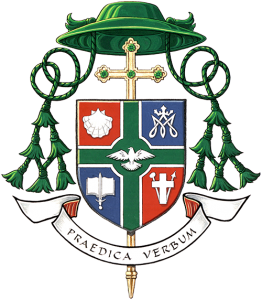Office of the Bishop
Chief teacher, sanctifier, and shepherd of God’s people
The diocesan Bishop is the chief teacher, sanctifier, and shepherd of God’s people. Most Bishops are given a diocese to govern spiritually, making sure the priests, deacons, pastoral workers and catechists in their diocese are preaching the Gospel and teaching sound doctrine to the flock. He is the principal teacher. The Bishop is the primary dispenser of all the sacraments. He has oversight of the liturgy.
He possesses the fullness of Orders, so that the fullness of Christ’s grace can flow through in sacramental form, to the sanctification of the faithful. Through his relationships with the priests of his diocese, the Bishop is able to shepherd the people of his diocese. The Bishops have been given a special outpouring of grace, to continue the work that the Apostles started.
When the seat of the Bishop is vacant (sede vacante), either the Consultors elect a Diocesan Administrator, or the Pope appoints an Apostolic Administrator. Either one serves as the ordinary (officer of the church) for a diocese until a new Bishop is appointed. The (Apostolic) Administrator generally holds the same authority as a diocesan bishop, but he is restricted by canon law in certain matters.
Coat of Arms
Heraldry originated about a thousand years ago in Europe, where it was used by the warrior classes as a means of differentiating combatants on the field of battle. As Europe developed and the feudal warrior class disappeared, the practice of identifying one’s possessions with personal emblems flourished. Ecclesiastical heraldry grew out of this practice, initially to differentiate between the various degrees of the clerical estate. The Pope and most bishops adopt a personal coat of arms, which today is used primarily to identify communications from their particular office.

Ms. Carole Schryer



